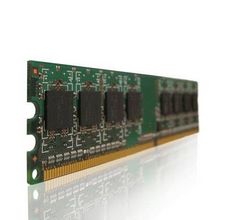Would you like to make this site your homepage? It's fast and easy...
Yes, Please make this my home page!
Importance Of RAM In Computer:

Many people believe that the processor speed controls the speed of a computer. The truth is that random access memory (RAM) also plays a very important role in how quickly your computer processes commands.In fact, in some ways RAM is even more important than processor speed.
The Facts:
A 2 gigahertz (GH) single-core processor will run the majority of programs that most people use today. However, if a computer with a very fast processor has inadequate system RAM, it may still run slowly, especially when running multiple programs.
Features:
Most computers today use double data rate synchronous dynamic random access memory (DDR SDRAM). This is a very inexpensive form of RAM with twice the bandwidth of single data rate (SDR) SDRAM. However, DDR SDRAM is slow and inefficient when compared with static memory (SRAM). SRAM is too expensive to be installed in most computers, so instead of using it as system memory, most manufacturers install SRAM on the processor to form a small yet ultra-fast cache. The DDR SDRAM chips on the motherboard access data on the hard drive, then send that data straight to the cache, where the processor can access and execute it.
Benefits:
You'll get more benefits from installing more RAM than you will by installing faster RAM. This is because faster RAM is considerably more expensive than RAM that operates at slower speeds, yet doesn't offer a significant performance boost for most common computer tasks. Adding more RAM can be very helpful if you're doing a lot of multi-tasking or accessing multiple programs at once. It also may enable you to run more graphics-intensive programs such as image and video editing programs, games and multimedia software such as DVD and CD players.
Considerations:
When a computer runs out of space in RAM to store the programs it's running, it will begin to store the data in a pagefile on the hard drive. Your computer's hard drive is significantly slower than its RAM. When using a pagefile, your computer must write the data to virtual memory on the hard drive, then read it again. While doing this, the computer must wait while the platters spin up and the read head accesses the data. One of the most important signs that your computer needs more memory is a noisy phenomenon called "thrashing," in which the computer's processes slow to a near halt while the hard drive accesses itself almost constantly.
Prevention/Solution:
If you find that your computer is running slowly, adding more RAM may help. Always check your computer's documentation to see what type, amount and speed of RAM the manufacturer recommends. Also check the software programs you normally run for their RAM requirements.
for more details please click:
